Editor’s notes: "Holistic Health" is a concept emphasised by PCD. “Health” should refer not only to our physical wellbeing but also to our spiritual wellbeing, and whether we feel good and at peace in our interaction with the environment and the society. “Ecological health” is therefore part and parcel of “holistic health”. When ecological health is promoted among ethnic-minority groups, emphasis is placed on reflecting on the meaning and value of traditional culture. In practice, the focus is on finding out which parts of the traditional culture help with conserving the natural ecology and building a harmonious community for sustainable living.
In October this year, PCD collaborated with Kunming Institute of Botany, of the Chinese Academy of Sciences, to support a group of Yunnan artists from 12 races of the province (Han and 11 ethnic minorities) to portray their understanding of ecological health through painting. The art work was later exhibited at the “International Conference on Eco-Health 2012” held in Yunnan. The exhibition aimed to review the recent history of Yunnan’s ethnic minority groups in the past few years and to explore how to utilise environmental awareness, and the traditional knowledge embedded in ethnic culture, to promote environmental protection. Dozens of these paintings were created, with brilliant colours, and they embraced a variety of styles. Here below we choose one painting from each race. These works reflect the artists’ interpretation of a harmonious village, embody the concepts held by the ethnic minorities on the protection of Nature and the ecology, and show how traditional religious beliefs effectively guide the villagers to cherish their natural environment.
|
Baipho Homes (Li Jinjun) |
|
Baipho |
|
Baipho people inhabit Dali Bai Autonomous Prefecture in the western part of Yunnan Province, through which Chamagudao (the Ancient Road of Tea and Horse), an important trade route in ancient times, passes. Baipho culture shows the influence of Confucianism, Taoism, Tibetan Buddhism, Southeast Asian culture and folk worship of Benzhu[1]. This is clearly demonstrated in the local architectural design.
This painting shows that Baipho people pay attention to fengshui in the layout of their homes. For example, the main house behind the courtyard has its back to the mountain. This serves to keep off the cold wind in winter. The ridge of the roof is parallel to the mountain range. This is said to help protect the house from wind and flood. There is no large open space behind the main house but the wide open courtyard in front ensures a good deal of sunlight and ventilation. The stream in front of the house ensures the villagers have the water they need and makes it easy for them to grow crops and rear animals. Traditional wisdom can be observed in the rules for the layout of Baipho homes. These rules have been passed from generation to generation.
|
|
+ Click to enlarge photo |
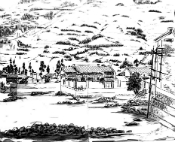 |
|
|
Fish Farming in Rice Fields (Beng Youwan) |
|
Dai |
|
Dai people inhabit Dehong Dai and Jingpo Autonomous Prefecture as well as Xishuangbanna Dai Autonomous Prefecture. In the course of a few thousand years, Dai people have developed a forest culture and the accompanying traditional wisdom, including knowledge of edible wild plants and medicinal herbs. They have also developed a perfect irrigation system, mainly for paddy cultivation. The wisdom of rice-fish farming is depicted in this painting. Before rice seedlings are transplanted in spring, Dai people release fry into the paddy fields. Breeding fish in paddy fields not only results in a much higher output of the crop; the fields are very good breeding grounds for the fish.
|
|
+ Click to enlarge photo |
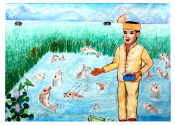 |
|
|
Spring Arrives Early in the Mountain Village (Wang Shunjin) |
|
Han |
|
Chenggong County, which is inhabited by Han people, lies at the outer rim of Kunming City. Due to accelerated urbanisation, Chenggong is now incorporated into the city and its agriculture has also entered an era of intensive development. Local farming, which used to be a kind of traditional natural resource management, now relies on biochemicals and petrochemicals for the increase in output. In this painting, the farmer painter uses daring, exuberant and bright colours as well as sharp and clear lines to depict what in his eyes are the opulence and harmony of the life of farming in Chenggong. Farmers’ love of the land and the natural environment is also depicted.
|
|
+ Click to enlarge photo |
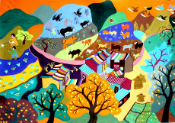 |
|
|
A Community Restores Farmland to Forest (Jiang Bimei) |
|
Jingpo |
|
The Jingpo live mainly in Dehong Dai and Jingpo Autonomous Prefecture in the west of Yunnan Province. Like their neighbours, the Bulang and the Wa, Jingpo people have a long history of shifting farming by practising slash-and-burn. Every village divides their forest land into 7, 8 or 10 parts. Every year trees on one part of the forest land are cut down and burnt and the land is used for farming. In this way, a rigorous and orderly farming cycle that allows land to lie fallow is developed. Trees in the forest are cut down and burnt in winter and spring as a way to get rid of pests. The ash becomes fertiliser for the fields. Seeds are then sown in the rainy season. This painting shows a Jingpo community growing rare and precious varieties of trees such as teak in the forest, after the policy of restoring farmland to forest was implemented.
|
|
+ Click to enlarge photo |
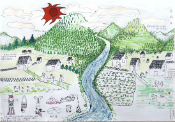 |
|
|
Brewing Wine in Duanyan Festival* (Yu Haiqing) |
|
Lisu |
|
Lisu people are scattered in northern Thailand, northern Laos, Eastern Burma and Southeast India. In China, the Lisu mainly inhabit the southwest including Yunnan Province and mountainous and hilly areas of Sichuan Province. This painter lives at the border of China and Burma. It is an area covered by dense forests and is known for its Chinese fir trees, precious and rare animals as well as Chinese medicinal herbs. There is also an abundance of mineral and water resources. In the last few decades, Lisu people have gradually turned from shifting farming, hunting and gathering to sedentary farming. In this painting, some traditional Lisu ways of living and harvesting, such as collecting wild animals and plants, are shown. The painting depicts the custom of drinking medicinal wine during Duanyang Festival to prevent diseases. The plants used in the wine include garlic, chuanxiong rhizome, fireweed, noto-ginseng and pepper.
* Also known as Duanwu Festival or the Dragon Boat Festival.
|
|
+ Click to enlarge photo |
 |
|
|
Harvest Time (Wang Jiancai) |
|
Miao |
|
Miao people inhabit mountain and hilly areas of Southeast Asian countries, and their main occupation is farming. Miao people are migrant people. They migrate to a place, live there for a period of time and move to another place. In Yunnan, the Miao people live mainly in the northeastern and central areas of the province, where the environment is barren and formidable. How to survive in a frail natural environment is the main issue Miao people face every time they migrate. Because of this, Miao people understand very clearly the importance of conserving natural resources. The painter lives in a mountainous area where lack of water is an ongoing problem. For him, a harmonious village is a village surrounded by many water sources or where there is an abundance of water. Expressing his wish for water, the painter depicts a beautiful scene of a village nourished by water.
|
|
+ Click to enlarge photo |
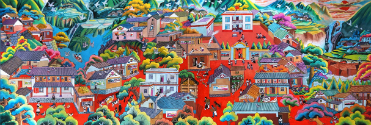 |
|
|
God of Five Grains (He Xiudong) |
|
Naxi |
|
The Naxi people inhabit the border area between Yunnan, Sichuan and Tibet. Their religion is known as Dongba. According to contemporary ecologists, Dongba, the traditional faith of the Naxi people, places emphasis on the protection of natural environment. Dongba has therefore effectively conserved the biodiversity of the local area. However, with modernisation and economic development, many environmentally-friendly ways of production and living are being given up. The god of the five grains, who is depicted in the painting, is one of the most important gods for the Naxi people. He is in charge of the cultivation of grains and the breeding of livestock. In their life of production, Naxi people pay their respects to the god who protects their crops and their livestock.
|
|
+ Click to enlarge photo |
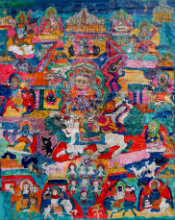 |
|
|
The Craft of Food Production of the Wa People (Liu Ruyan, Ding Yifei) |
|
Wa |
|
The mountainous area between the Lancang (Mekong) and Salween Rivers is partly Burmese and partly Chinese territory. The Wa people’s traditional knowledge of food production is shown in this painting. On the left side of the painting is depicted the craft of wine brewing. Wa people think that “without wine there is no li*”. Therefore there is always wine in the house. On the right side of the painting, the traditional way of making food from soybeans is depicted. The need to make traditional food helps to preserve local varieties of crop. Red rice and soybean are crops that Wa people grow every year.
*Li is a Chinese word which simultaneously means ritual, proper conduct and propriety.
|
|
+ Click to enlarge photo |
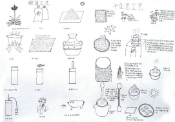 |
|
|
Ashima (Painting provided by Yang Jiankun) |
|
Yi |
|
The Nosu, a branch of the Yi people, live in Liangshan Prefecture in Sichuan Province. Their main occupation is farming and livestock rearing. They cultivate crops including barley, maize, potatoes and oats. Pigs, chickens and sheep are also raised. Nosu people also gather fruits and hunt. This painting is by a bimo* who lives in Meigu County, Liangshan Prefecture. It depicts the farming tradition of the Sani people, another branch of the Yi, who engage in farming and grazing activities including paddy cultivation and sheep rearing.
** Bimo is a Yi word, referring to Yi priests who perform religious rituals.
|
|
+ Click to enlarge photo |
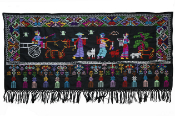 |
|
|
Forests and Terraced Fields (Long Zihui) |
|
Zhuang |
|
The works of the Zhuang artists exhibited this time are mainly woodcuts which depict the religious beliefs of the Zhuang people, worshipping the sun, water and forests. Most of the Zhuang inhabit river valleys at low altitudes. They grow paddy rice and maize. Zhuang villagers believe that forests and other living things have their own gods to protect them, and destroying the forests will infuriate the gods and bring about misfortune to the villagers. For this reason, mountains and forests adjoining Zhuang villages are very well conserved. Zhuang villagers also enact rules for protecting the forests, with particular attention drawn to certain functions of forests including those with water supplies, those preserved for scenery and those for worship and sacrifices. This woodcut illustrates the forests surrounding a village that will protect and bless the grains and crops being grown.
|
|
+ Click to enlarge photo |
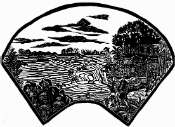 |
|
| Ecology of a Tibetan Community (Painting provided by Kunming Institute of Botany, Chinese Academy of Sciences) |
| Tibetans |
|
The Tibetans live mainly in Tibet Autonomous Region but are also scattered in Qinghai, Gansu and Yunnan. They usually inhabit mountain areas at high altitudes where the snow on the peaks never melts. The worship of “sacred mountains and lakes” is the most outstanding feature of Tibetan traditional culture. The worship of mountains and lakes was reinforced when Buddhism flourished on the Qinghai-Tibetan Plateau. In the eyes of Tibetans, one’s soul never dies. The body is only a shell. Life is reincarnation in the six realms of existence and the cycle of cause and effect never ends. Human beings are therefore only a part of nature. The belief in reincarnation and the cycle of cause and effect becomes a powerful spiritual motive to protect plants, animals and the environment.
|
| + Click to enlarge photo |
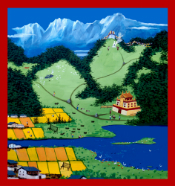 |
|
|
Hani Local Crop Calendar (Mei Lan) |
|
Hani |
|
For generations, Hani people have been living in the Honghe area in the middle of Yunnan Province. In around the middle-18th Century, some Hani people migrated to Xishuangbanna. Over a century ago, Hani people began to practise crop rotation by cultivating dry rice and rattan. Apart from cultivating staple foods such as rice and maize, they cultivate perennial crops such as rattan, bamboo and tea in the crop rotation. The traditional belief system of the Hani is animism and ancestor worship. They believe that plants and animals have a sacred supernatural power. Each soul has its final home. Burial sites in the mountain and forest are protected. With economic development, the life and the production of Hani people are undergoing dramatic changes. Nevertheless, Hani people still play an important role in the conservation of biodiversity.
The theme of this painting is Hani people’s local crop calendar. In this calendar, a year is divided into three seasons. The cold season is called congta and runs from the eleventh month until the second month of the following year in the traditional Chinese calendar. The warm season is called woduo and is from the third to the sixth month. The rainy season is called reweng and is from the seventh to the tenth month.
|
|
+ Click to enlarge photo |
 |
|
-
Benzhu worship is a religious belief unique to the Baipho people. It has its origins in the worship of the god of land and in sacrificial practices in farming. It is polytheistic. Every place and every village has its own benzhu temple. In the temple, villagers worship the benzhu god of their place/village. Sometimes the same benzhu god is worshipped by a few villages. The benzhu god attends to all sorts of affairs of the human world, such as overseeing diseases, armies and warriors, and animal rearing.













